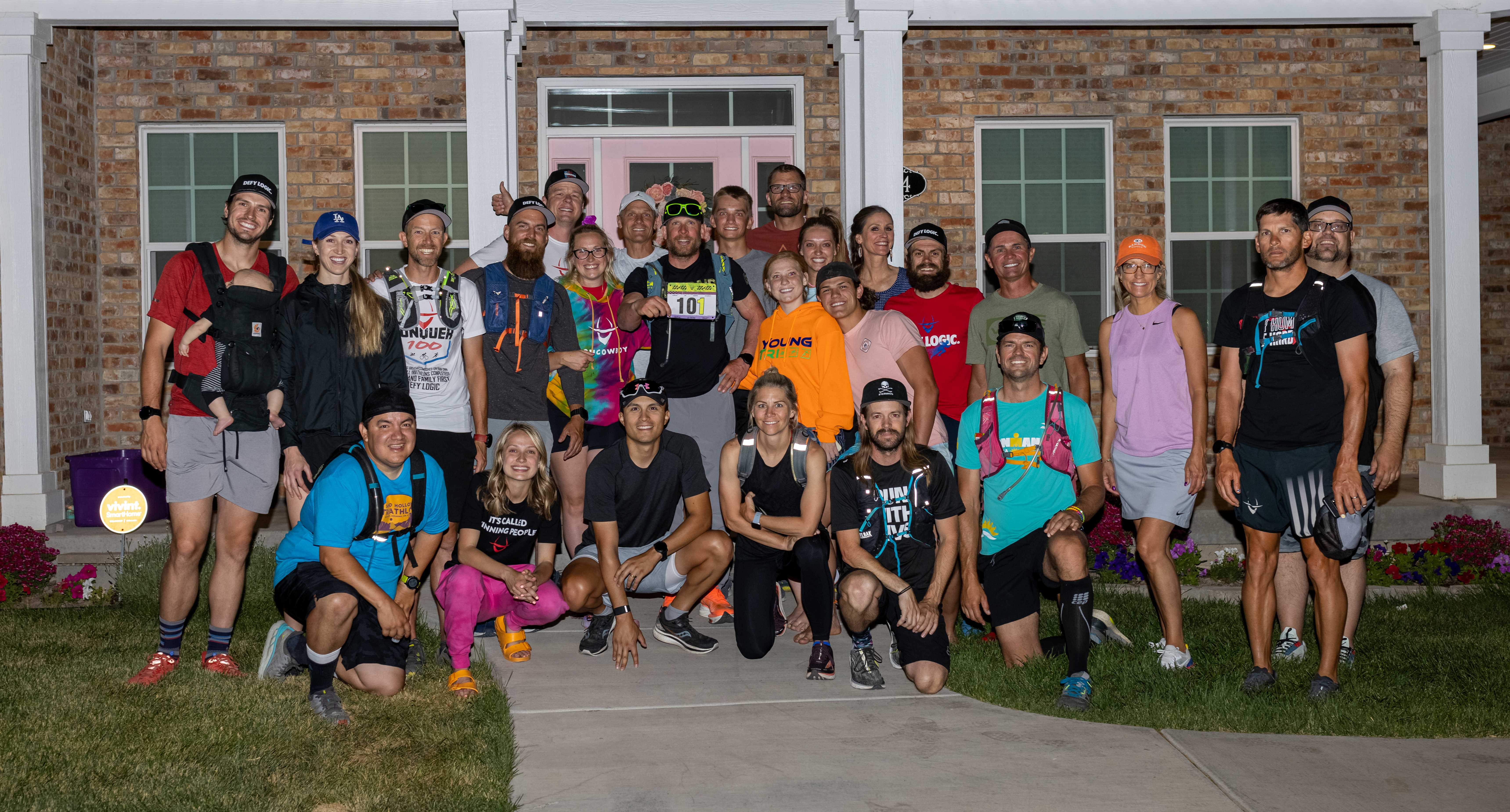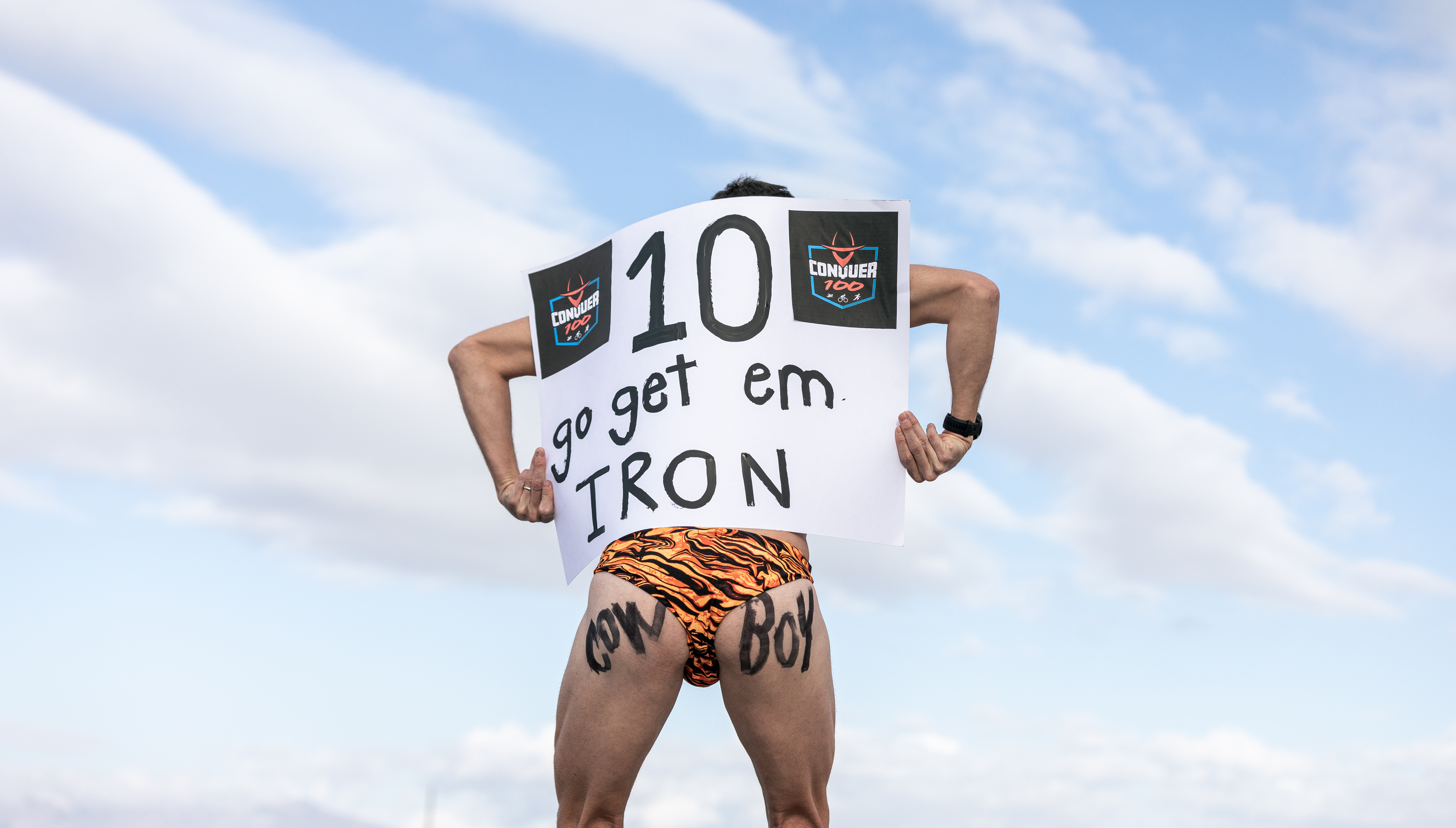Iron Cowboy announces retirement from triathlon after completing latest challenge
A week since completing a record-breaking 101 consecutive Iron-distance triathlons, the world’s toughest endurance triathlete sits down for a behind-the-scenes chat with 220's Kate Milsom.

Wanting to end his endurance triathlon career with a bang, James Lawrence (AKA the Iron Cowboy) decided to run 100 consecutive Iron-distance triathlons in 100 days. One week on from completing the incredible Conquer100 challenge, he picks up the phone for a behind-the-scenes chat with us…
220: You’ve finally got to the end of the 101 consecutive Iron-distance triathlons, how do you feel?
I feel exhausted [laughs]. It was a challenge that lasted a quarter of a year, and I think I was almost in a crisis state. Your mind is so powerful that it puts you in a state of [survival]. It tries to protect you from what’s been happening. Then when you finish, you start to feel all those things that your mind’s been sheltering from you. I don’t feel amazing, but it’s only been one week and that’s part of the healing process.
220: What made you decide it had to be 100, it had to be Iron-distance triathlons and they had to be one after another?
We did the 50 days [of Ironman races] in 50 states, which was six years ago now. When the pandemic hit, my calendar got completely wiped clean and I’d always thought that I had one more challenge in me. I’m now 45, so a little bit older. I just wanted to remove the chaos and logistics of the 50 and see how many consecutive we could do. Seventy-five didn’t really scare me, so we settled on the number 100.
Seventy-five didn’t really scare me,
so we settled on the number 100
220: Okay, so why did it end up being 101?

It was just such a powerful lesson, in my opinion. I don’t like to teach lessons by speaking them, I like to teach lessons by setting an example and doing them. The purpose of it was to show people two things: that when you’ve reached your goal and you’ve celebrated, you can do more. A lot of people just sit in celebration mode for too long. The bigger portion of that was when you think you’re beaten, exhausted, and can’t possibly take one step towards your goal, you have one more in you. In my case, it was one more full-distance.
I really wanted to set an example for people that are struggling, who don’t think they can wake up tomorrow and do it one more time. So that was the premise behind it. I truly believe that when we do one more, it’s done alone. That’s why we didn’t tell anybody about it. We just showed up at the pool solo and started on a solo day.
I really wanted to set an example for people that are struggling, who don’t think they can wake up tomorrow
220: What was your motivation to keep going when things got tough?
When you commit to something, I believe that your word is your bond and you do everything you can to try to accomplish it. I had a couple hundred thousand people watching me on social media. And we were also trying to raise money for the charity [Operation Underground Railroad, rescuing children from sex trafficking and exploitation].
I’ve never been known as a quitter, someone who cuts corners, so I just wanted to stay true to that and really do everything I could to continue on the journey without quitting.
220: What exactly was involved in ensuring the success of this challenge?
Nothing great is ever accomplished on your own. My wife is a huge part of this and we’ve got five kids; they’re a big part of the journey. Lucy [my daughter] did an unbelievable job with the social media; she’s an 18-year-old girl just out of high school.
The community that came out and rallied behind us and participated with us, and all the sponsors. It was truly a group effort and couldn’t have been done without them.
220: What training did you do to prepare for this challenge? And do you feel like you were sufficiently prepared for the reality of such a feat?

We decided to do the project in March 2020, so I just started working on my general fitness and I did a four-month training camp from November through to March. We did a lot of swimming, biking, running, and strength training, as well as a lot of recovery.
But you can’t just get physically fit and take on a challenge of this magnitude without the mental side of stuff – I’ve been building that my entire career. I started as a wrestler. We did the 2010 world record, the 2012 record, and the 50 through the 50 states. All of those challenges helped build the mental fortitude, grit and toughness that is required to do a mental challenge that lasts over a quarter of a year.
220: What were the defining moments during the challenge that really stand out to you?
To be honest with you, it is one big day. It’s too close to the end of the journey to really isolate those highs and lows. Obviously, day 100 and 101 were a high, every single day when we finished was a high. But there was a lot of pain, a lot of struggle, a lot of frustration, a lot of sadness and a lot of loneliness in between those moments. It was definitely a journey.
220: Did you ever think about giving up?
I think it’s human nature to have doubt and to want to quit, but it’s our choice to act upon that. Every single member of the team, including me, had moments of tears or frustrations, or processing what’s happening. I think it’s important to have those experiences, process those emotions, and have a quick turnaround to get back on track towards accomplishing your goal.
There was a lot of pain, a lot of struggle…
a lot of loneliness
220: Tell us about some of the people that came to race alongside you. Do any names stick in your memory?

I got messages from George St-Pierre, an MMA fighter. I got signed jerseys from [former American football stars] Drew Brees and Troy Polamalu. I had Rich Roll and Jesse Itzler join me. And my good friend who’s struggling badly with cancer, Tommy Rivers.
Tommy was one of the silent wingmen on the 50; him and I have just become great friends. He’s been through something incredible, to have him show up and walk six miles with us, with walking poles and struggling to breathe, was just remarkable and I really appreciated the effort.
220: Do you worry that such an extreme feat could influence athletes to push themselves dangerously beyond their limits?
No. I think that with the right preparation, team and protocols in place, it’s not dangerous. That’s exactly what we’re trying to showcase. People aren’t achieving their mental and physical limits; we’re limiting what is possible as human beings. Hopefully, I showcased that with the right team and everything in place, look what we can accomplish.
Everybody thought that the 50 challenge was impossible, to do double and accomplish it with no controversy, with overwhelming support, that was an undisputed effort that nobody can deny. It will go down as the greatest endurance feat in sports history.
It will go down as the greatest endurance feat in sports history
220: How did your family cope with the early starts and with their lives revolving around this challenge?
I don’t have any regrets. We discussed it as a family beforehand, and we knew the great sacrifice that it was going to take. They signed off on it. My kids’ lives didn’t get disrupted. It was a little bit more chaotic, but they still did fun things, they had prom and my daughter graduated from high school.
That’s the other big reason why we chose to do it in a single location here in Utah, it was so that the family could stay in the home and normal lives could continue as best as possible. It was still a massive sacrifice for my wife Sunny – she did an unbelievable job at supporting me and doing everything behind the scenes that goes unnoticed and unrecognised.
220: What do your kids think of your extreme challenges? Do they want to be just like you, or do they think you’re crazy?

[Laughs] None of them want to do what I do! To them, I’m just dad, just James. That’s how it should be. There should be balance and family time, and to me the fact that they think that I’m just dad means that we’ve done some right things in our parenting and our lifestyle choices.
220: Having now completed the challenge, would you do anything differently?
You never want to change a journey because the lessons that are learnt in that journey are due to mistakes, or relationships, or the path that we’ve been put on. So, to want to change that I think would be a disservice to human life, and the journey that we’re all on.
So no, I don’t think I’d change anything because I met the people that I met because of the way that we did things. I experienced highs and lows because of the way we did things. I don’t think I’d want to change any of that, because that’s how we learn and grow as humans.
220: What’s next?
It’s family, recovery and in July we’re going to head to Mexico for a week [on vacation]. Then I am going to focus on my coaching career and my speaking career, we’re writing another book and we’ve filmed a documentary. And I’m going to get back into my grassroots of strength-training.
As you can see, I’m not built like a typical triathlete; I carry more muscle and I love that. I think I’m going to get more into gravel riding and strength training. I think I’m officially retired from triathlon.
I think I’m officially retired from triathlon
James Lawrence, otherwise known as the Iron Cowboy, is an ultra-endurance athlete living in Utah with his wife and five children. Having previously broken the Guinness World record for most Iron-distance triathlons ever completed in a year in 2012 (that’s 30 triathlons in 11 different countries), Lawrence skyrocketed to fame in 2015 when he completed 50 iron-distance triathlons in 50 consecutive days, each one in a different US state.
Inspired by these inhuman feats? Follow the Iron Cowboy on Instagram or check out his website for more information.
Photo credits: Matthew Norton














